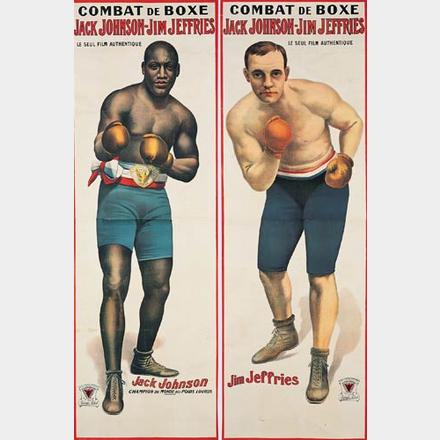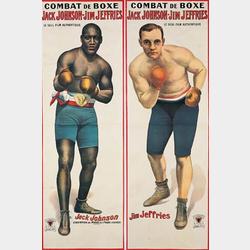Lot 7
Combat de Boxe/Jack Johnson-Jim Jeffries: Two Posters. 1910.
Sold
$10,925
Est.
$3,000
- $4,000
Live Auction
PAI-XLVII: Rare Posters
ARTIST
ANONYMOUS
Description
Artist: ANONYMOUS
Size: Each: 39 x 117 3/8 in./99 x 298 cm
Condition: Cond B-/Slight tears and stains, largely at folds, seam and edges.
Printer: Raleigh & Robert, Paris
Reference:
Combat de Boxe/Jack Johnson-Jim Jeffries: Two Posters. 1910.
These literally larger-than-life-size portraits were used to promote the filmed release of this historic heavyweight bout. Jack Johnson (1878-1946), born John Arthur Johnson in Galveston, Texas, emerged from the battle royals (dehumanizing fights between blacks for the amusement of white patrons) of his youth–he won his first professional 16-round match-up just shy of his sixteenth birthday–to defeat Tommy Burns in 1908 to become the world's first African-American heavyweight champion. Jim “The Boilermaker” Jeffries (1875-1953)–who stood 6 feet-3 inches tall and weighed in at 225 pounds in his prime–was an astounding natural athlete known for his enormous strength and stamina. Jeffries reigned as the world heavyweight boxing champion from 1899 to 1904, at which point he retired, having never lost a fight. He was revered by many people and considered the greatest athlete in the world. Jeffries came out of retirement to fight Johnson–dropping seventy-five pounds to do so–as a “Great White Hope,” and in his own words said he was responding to "that portion of the white race that has been looking to [him] to defend its athletic superiority." And though the racial overtones of the fight can’t be overlooked, the outcome was never in doubt once the first-round bell rang out–the fight-conditioned Johnson won easily beneath the sweltering midday sun of Reno, Nevada on July 4, 1910. The filmed version of the fight was done by nine cameramen, from the Essanay, Selig Polyscope and Vitagraph companies, and was released as a reserved-seat attraction, with a running time of over two hours. Because of the fight’s outcome–a black boxer besting a white one–the film was banned in some southern cities. Rare!
Size: Each: 39 x 117 3/8 in./99 x 298 cm
Condition: Cond B-/Slight tears and stains, largely at folds, seam and edges.
Printer: Raleigh & Robert, Paris
Reference:
Combat de Boxe/Jack Johnson-Jim Jeffries: Two Posters. 1910.
These literally larger-than-life-size portraits were used to promote the filmed release of this historic heavyweight bout. Jack Johnson (1878-1946), born John Arthur Johnson in Galveston, Texas, emerged from the battle royals (dehumanizing fights between blacks for the amusement of white patrons) of his youth–he won his first professional 16-round match-up just shy of his sixteenth birthday–to defeat Tommy Burns in 1908 to become the world's first African-American heavyweight champion. Jim “The Boilermaker” Jeffries (1875-1953)–who stood 6 feet-3 inches tall and weighed in at 225 pounds in his prime–was an astounding natural athlete known for his enormous strength and stamina. Jeffries reigned as the world heavyweight boxing champion from 1899 to 1904, at which point he retired, having never lost a fight. He was revered by many people and considered the greatest athlete in the world. Jeffries came out of retirement to fight Johnson–dropping seventy-five pounds to do so–as a “Great White Hope,” and in his own words said he was responding to "that portion of the white race that has been looking to [him] to defend its athletic superiority." And though the racial overtones of the fight can’t be overlooked, the outcome was never in doubt once the first-round bell rang out–the fight-conditioned Johnson won easily beneath the sweltering midday sun of Reno, Nevada on July 4, 1910. The filmed version of the fight was done by nine cameramen, from the Essanay, Selig Polyscope and Vitagraph companies, and was released as a reserved-seat attraction, with a running time of over two hours. Because of the fight’s outcome–a black boxer besting a white one–the film was banned in some southern cities. Rare!






